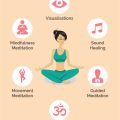Essential Guide to Safe and Simple Yoga for Pregnant Women
Yoga during pregnancy is not only safe but can be incredibly beneficial for both the mother and the baby. With the right guidance, pregnant women can enjoy a gentle, effective yoga practice that supports their health, reduces stress, and prepares them for childbirth. This article provides a comprehensive guide on how to practice yoga safely during pregnancy, addressing key concepts, historical insights, practical applications, and considerations for different stakeholders, including yoga instructors, healthcare providers, and expecting mothers.
Introduction
Pregnancy can bring both physical and emotional challenges. Many women turn to yoga as a holistic way to improve flexibility, build strength, and maintain a calm mind during this period. However, concerns about safety and appropriateness often arise. This guide aims to dispel myths, provide practical advice, and offer insights into making yoga a safe and rewarding experience throughout pregnancy.
Key Concepts
- Safety Modifications: Yoga poses need to be adapted as the body changes. Avoid deep twists, excessive backbends, and lying on the belly. Focus on poses that build strength, enhance breathing, and promote relaxation.
- Mind-Body Connection: Yoga encourages mindfulness and breath control, helping pregnant women stay centered and manage stress.
- Trimester-Specific Adjustments: Each trimester comes with its unique challenges and modifications in yoga practice are crucial to accommodate the growing belly and changing balance.
Historical Context
Yoga has been practiced for thousands of years, originating in ancient India as a discipline that integrates physical, mental, and spiritual practices. While its classical forms were not specifically tailored to pregnancy, modern prenatal yoga has emerged as a specialized form of yoga. In the 20th century, as yoga became more popular in the West, attention shifted to adapting poses and techniques to suit pregnant women, aligning with medical advances and a deeper understanding of maternal health.
Current State Analysis
Today, prenatal yoga is widely accepted and recommended by healthcare professionals for its benefits. It’s especially popular due to its focus on breathing techniques, relaxation, and gentle stretching, all of which are helpful in managing pregnancy discomforts like back pain, swollen feet, and anxiety. However, there is a need for more standardized guidelines to ensure safe practices across different yoga schools and instructors. Research into the effects of yoga on pregnancy outcomes is still developing, with studies showing promising results in terms of stress reduction and improved labor experiences.
Practical Applications
Yoga for pregnant women should emphasize:
- Gentle Stretches: Focus on opening the hips, relieving tension in the lower back, and creating space for the baby.
- Breathwork (Pranayama): Learning controlled breathing techniques can help in managing labor pains and promoting relaxation.
- Strengthening: Strengthening poses like modified Warrior II help prepare the body for the physical demands of childbirth.
Case Studies
| Case | Pregnancy Stage | Challenges | Yoga Approach |
|---|---|---|---|
| Sarah, 1st Trimester | Early pregnancy | Fatigue, nausea | Focus on breathwork and gentle seated poses, avoiding any strenuous activity. |
| Lisa, 2nd Trimester | Mid-pregnancy | Lower back pain | Incorporated cat-cow stretches, pelvic tilts, and supported bridges to relieve tension. |
| Amy, 3rd Trimester | Late pregnancy | Difficulty with balance | Emphasized poses using support like chairs and walls, avoiding standing poses without props. |
Stakeholder Analysis
Several stakeholders are involved in ensuring a safe yoga practice for pregnant women:
- Yoga Instructors: Must be trained in prenatal modifications and aware of common pregnancy-related issues.
- Healthcare Providers: Doctors and midwives should provide guidance on any medical concerns related to yoga.
- Pregnant Women: The main beneficiaries, who should listen to their bodies and practice within their comfort zone.
Implementation Guidelines
- Start yoga early in pregnancy to build strength and flexibility gradually.
- Avoid lying flat on your back after the first trimester to prevent pressure on the vena cava.
- Use props like bolsters, blankets, and blocks to support poses and reduce strain on joints.
- Practice breathing techniques daily to help prepare for labor and reduce anxiety.
- Ensure your instructor has experience with prenatal yoga, and always consult with your healthcare provider before starting a new exercise regime.
Ethical Considerations
There are several ethical considerations in prenatal yoga. Yoga instructors must respect the limitations and individual needs of pregnant women. Over-exertion or pushing beyond comfort should be discouraged. Furthermore, misleading claims about yoga curing pregnancy complications or guaranteeing certain birth outcomes should be avoided. Pregnant women must always be informed about the limitations of yoga and the importance of medical advice.
Limitations and Future Research
While prenatal yoga is widely practiced, more research is needed to establish firm guidelines on its benefits and limitations. Many studies rely on self-reported data, which can be subjective. Future research should focus on long-term outcomes, comparing different yoga practices during pregnancy, and their impact on labor and postnatal recovery.
Expert Commentary
Prenatal yoga offers numerous benefits, from physical relief to emotional calm. However, it’s critical for instructors to be properly trained, and for pregnant women to practice with caution, especially as their bodies change. Yoga should complement, not replace, medical advice and care. As we move forward, integrating yoga more closely with prenatal healthcare systems could further enhance the well-being of pregnant women and lead to better outcomes in childbirth and recovery.
Mastering the Art of Cooling Yoga Breath for Instant Relaxation and Energy Balance
Breathing techniques are a foundational element in yoga practice, offering a myriad of benefits ranging from stress relief to energy regulation. Among these, the Cooling Breath, or Shitali Pranayama, stands out as an ancient technique designed to cool the body and calm the mind. In this comprehensive guide, we explore the intricacies of the Cooling Yoga Breath, its historical roots, modern-day applications, and how to incorporate it into daily life.
1. Introduction
The practice of yogic breathing spans thousands of years and has evolved as an essential tool for physical, mental, and emotional well-being. One particular technique, the Cooling Breath (Shitali and Sitkari Pranayama), is increasingly gaining attention for its ability to cool the body and soothe the nervous system. This article delves into the key concepts behind the Cooling Breath, its historical context, current state of research, practical applications, and potential implications for future health practices.
2. Key Concepts
- Shitali Pranayama: A yogic breathing technique where air is drawn in through the curled tongue or teeth to cool the body.
- Cooling the Body: Helps lower body temperature, alleviate heat-related stress, and balance emotions.
- Prana: The vital life force that sustains physical and mental functions, regulated through breath control.
- Vata and Pitta Doshas: Cooling breath specifically aids in balancing these Ayurvedic body types.
3. Historical Context
The origins of Cooling Breath date back to ancient Ayurvedic texts, where it was recommended to pacify excess heat in the body and mind. This technique, known as Shitali or Sitkari Pranayama, was used to combat high summer temperatures and promote tranquility. Over centuries, yogis have employed this method to maintain a balanced internal temperature and manage emotional imbalances, which were often believed to result from an overheated body.
4. Current State Analysis
In modern wellness practices, Cooling Breath has been studied in various scientific contexts. Research supports the physiological cooling effects of Shitali Pranayama, showing its benefits in reducing core body temperature, lowering heart rate, and promoting relaxation. This practice is now part of numerous yoga and meditation programs aimed at stress reduction, management of anxiety, and physical recovery after intense activity.
4.1. Benefits Supported by Research
- Reduction in cortisol levels, aiding in stress management
- Helps in managing heatstroke and overheating in athletes
- Balances the body’s autonomic nervous system by activating the parasympathetic response
- Increases mental clarity and focus
5. Practical Applications
Practitioners can incorporate Cooling Breath into their daily routine in various situations, from handling high temperatures to calming nerves before an important meeting. By learning to regulate the breath, individuals can influence their physical and mental states effectively.
5.1. Step-by-Step Guide
- Find a comfortable seated position. Keep the spine straight and shoulders relaxed.
- Roll the tongue into a U-shape, or if unable, clench the teeth lightly with lips parted.
- Inhale deeply through the rolled tongue or teeth, feeling the cool air enter the body.
- Exhale slowly through the nose.
- Repeat for 5-10 cycles, gradually extending to longer sessions as you build comfort with the technique.
5.2. When to Use
- During hot weather or after physical exertion
- In moments of stress, to bring calmness and clarity
- After intense mental activity, to relax the mind
6. Case Studies
Several case studies highlight the efficacy of Cooling Breath for different populations:
| Subject | Condition | Results |
|---|---|---|
| Yoga Practitioners | Excessive heat during summer training | Improved thermal regulation and reduced heat-related exhaustion |
| Athletes | Heatstroke management | Cooling Breath helped reduce core body temperature after intense games |
| Office Workers | Stress and anxiety from work | Reported better focus and lower anxiety levels after daily practice |
7. Stakeholder Analysis
Implementing Cooling Breath at a broader scale involves various stakeholders, from healthcare professionals to wellness industries:
- Healthcare Providers: Can integrate Cooling Breath into stress management programs.
- Corporate Wellness Programs: May benefit employees in high-pressure environments.
- Yoga Instructors: Can offer it as part of their teaching to help students cool down.
8. Implementation Guidelines
To successfully incorporate Cooling Breath into daily practice or larger wellness programs, consider the following guidelines:
- Education: Provide thorough instruction on proper breathing technique.
- Customization: Tailor the duration and frequency of practice based on individual needs.
- Monitor Progress: Track improvements in stress management and physical cooling to measure effectiveness.
- Combine with Other Techniques: Pair Cooling Breath with other relaxation methods like meditation for enhanced results.
9. Ethical Considerations
While the Cooling Breath is generally safe, ethical considerations should be taken into account, especially in medical and therapeutic settings:
- Over-reliance on Pranayama: Should not replace medical treatments for conditions like heatstroke.
- Inclusivity: Ensure the technique is accessible to people with physical limitations that may prevent proper tongue positioning.
10. Limitations and Future Research
Despite the benefits of Cooling Breath, more research is needed to fully understand its long-term effects. Current limitations include:
- Lack of large-scale clinical trials on diverse populations
- Unclear mechanisms of how Cooling Breath affects deeper emotional regulation
- Limited data on the effects in extreme climates outside India, where it originated
Future research could explore these areas, along with potential applications in mental health therapies and corporate stress relief programs.
11. Expert Commentary
Experts in yoga and breathing techniques, as well as healthcare providers, highlight the Cooling Breath’s versatility:
“The Cooling Breath is one of the most effective and accessible pranayamas for managing stress and overheating. Its simplicity allows anyone, from yoga beginners to seasoned practitioners, to harness its benefits.” – Dr. Anjali Mehta, Yoga Therapist
“Incorporating Shitali Pranayama into wellness routines is a game-changer for those living in warmer climates or working in high-stress environments. It’s an ancient technique, yet it addresses very modern problems.” – James Williams, Corporate Wellness Consultant
As this article has shown, the Cooling Breath is not just a tool for physical cooling but a powerful practice for mental clarity and emotional balance.








